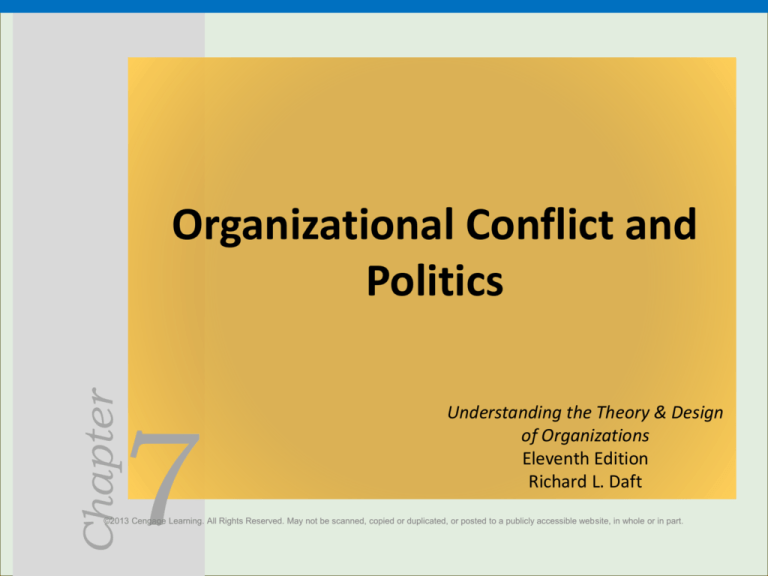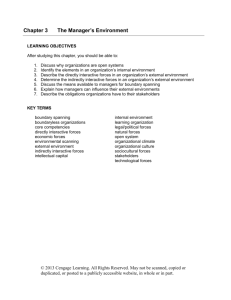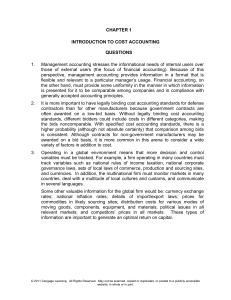
Chapter
Organizational Conflict and
Politics
7
Understanding the Theory & Design
of Organizations
Eleventh Edition
Richard L. Daft
©2013 Cengage Learning. All Rights Reserved. May not be scanned, copied or duplicated, or posted to a publicly accessible website, in whole or in part.
Purpose
•
•
•
•
•
Nature of intergroup conflict
Use of power-Political/Rational model
Political tactics to manage the conflicts
Reduce conflict among individuals and groups
Characteristics of organization that contribute
the conflicts
Conflict is similar to competition but more severe
2
©2013 Cengage Learning. All Rights Reserved. May not be scanned, copied or duplicated, or posted to a publicly accessible website, in whole or in part.
Interdepartmental Conflict in Organizations
•
•
Groups may be dispersed across the organization
Intergroup conflict requires three ingredients:
1. Group Identification: Perceive themselves
2. Observable Group Differences: Different places etc.
3. Frustration: Achieving goals, try to advance their
positions in relation to other groups
Goal achievement
pursuit of a common prize
Conflict is similar to competition but more severe
3
©2013 Cengage Learning. All Rights Reserved. May not be scanned, copied or duplicated, or posted to a publicly accessible website, in whole or in part.
Sources of Conflict
Some specific organizational characteristics can generate conflict.
These sources of intergroup conflict are goal incompatibility,
differentiation, task interdependence, and limited resources.
These characteristics of organizational relationships are determined
by the contextual factors of environment, size, technology, strategy
and goals, and organizational structure,
These characteristics, in turn, help shape the extent to which a
rational model of behavior versus a political model of behavior is
used to accomplish objectives.
4
©2013 Cengage Learning. All Rights Reserved. May not be scanned, copied or duplicated, or posted to a publicly accessible website, in whole or in part.
Sources of Conflict
Goal Incompatibility: Goals-reflect-objectives-interfere
another dep.goals
Differentiation: values-attitudes-standards of
behaviour-subcultural-…….driven
Task Interdependence. Dependence of one unitmaterials-resources-information-reciprocal
Limited Resources: power-budget
5
©2013 Cengage Learning. All Rights Reserved. May not be scanned, copied or duplicated, or posted to a publicly accessible website, in whole or in part.
MarketingManufacturing Areas of
Potential Goal Conflict
The potential for conflict is perhaps
greater between marketing and
manufacturing than between other
departments because the goals of
these two departments are
frequently at odds.
6
©2013 Cengage Learning. All Rights Reserved. May not be scanned, copied or duplicated, or posted to a publicly accessible website, in whole or in part.
Rational versus Political Model
• The rational model where behavior is not
random or accidental
– Goals are clear and choices are made logically
• The political model involves push and pull
debate regarding goals
– Organization groups have separate interests and
goals
7
©2013 Cengage Learning. All Rights Reserved. May not be scanned, copied or duplicated, or posted to a publicly accessible website, in whole or in part.
Sources of Conflict and Use of Rational
versus Political Model
8
©2013 Cengage Learning. All Rights Reserved. May not be scanned, copied or duplicated, or posted to a publicly accessible website, in whole or in part.
Top 10 Problems from
Too Much Conflict
©2013 Cengage Learning. All Rights Reserved. May not be scanned, copied or duplicated, or posted to a publicly accessible website, in whole or in part.
Tactics for Enhancing Collaboration
1. Create integration devices
2. Use confrontation and negotiation
3. Schedule intergroup consultation
4. Practice member rotation
5. Create shared mission and superordinate
goals
10
©2013 Cengage Learning. All Rights Reserved. May not be scanned, copied or duplicated, or posted to a publicly accessible website, in whole or in part.
Negotiation Strategies
11
©2013 Cengage Learning. All Rights Reserved. May not be scanned, copied or duplicated, or posted to a publicly accessible website, in whole or in part.
Power and Organizations
• Power is an intangible force in organizations. It cannot be seen, but
its effect can be felt.
• Power is often defined as the potential ability of one person (or
department) to influence other people (or departments) to carry
out orders or to do something they would not otherwise have
done.
• Other definitions stress that power is the ability to achieve goals or
outcomes that power holders desire.
• The achievement of desired outcomes is the basis of the definition
used here: Power is the ability of one person or department in an
organization to influence other people to bring about desired
outcomes.
• It is the potential to influence others within the organization with
the goal of attaining desired outcomes for power holders.
12
©2013 Cengage Learning. All Rights Reserved. May not be scanned, copied or duplicated, or posted to a publicly accessible website, in whole or in part.
Power and Organizations
• Power is the potential ability of one person to
influence other people to bring about desired
outcomes.
• Individual versus Organizational Power
– Legitimate Power
– Reward Power
– Coercive Power
– Expert Power
– Referent Power
13
©2013 Cengage Learning. All Rights Reserved. May not be scanned, copied or duplicated, or posted to a publicly accessible website, in whole or in part.
Power and Organizations
• Legitimate power is the authority granted by the organization to the
formal management position a manager holds.
• Reward power stems from the ability to bestow rewards—a
promotion, raise, or pat on the back—to other people.
• The authority to punish or recommend punishment is called
coercive power.
• Expert power derives from a person’s greater skill or knowledge
about the tasks being performed.
• The last, referent power, is derived from personal characteristics:
people admire the manager and want to be like or identify with the
manager out of respect and admiration.
• Each of these sources may be used by individuals within
organizations.
14
©2013 Cengage Learning. All Rights Reserved. May not be scanned, copied or duplicated, or posted to a publicly accessible website, in whole or in part.
Power versus Authority
Authority is more narrow than power
– Defined by the formal hierarchy and reporting
relationships
•
Power can be exercised upward, downward, and
horizontally
•
Authority is exercised downward along the
hierarchy
1) Authority is vested in organizational positions
2) Authority is accepted by subordinates
3) Authority flows down the vertical hierarchy
15
©2013 Cengage Learning. All Rights Reserved. May not be scanned, copied or duplicated, or posted to a publicly accessible website, in whole or in part.
Power versus Authority
1. Authority is vested in organizational positions. People
have authority because of the positions they hold, not
because of personal characteristics or resources.
2. Authority is accepted by subordinates. Subordinates
comply because they believe position holders have a
legitimate right to exercise authority. In most
North American organizations, employees accept
that supervisors can legitimately tell them what time
to arrive at work, the tasks to perform while they’re
there, and what time they can go home.
3. Authority flows down the vertical hierarchy.
Authority exists along the formal chain of command,
and positions at the top of the hierarchy are vested
with
more formal authority than are positions at
the bottom.
16
©2013 Cengage Learning. All Rights Reserved. May not be scanned, copied or duplicated, or posted to a publicly accessible website, in whole or in part.
Vertical Sources of Power
• Formal Position – legitimate power accrued to top
positions
• Resources – resources can be used as a tool for
power
• Control of Information – information is a primary
business source
• Network Centrality – being centrally located in the
organization and having access
• People – loyal executives/managers
17
©2013 Cengage Learning. All Rights Reserved. May not be scanned, copied or duplicated, or posted to a publicly accessible website, in whole or in part.
Vertical Sources of Power
• Formal Position – legitimate power accrued to top
positions
• Formal Position. Certain rights, responsibilities, and
prerogatives accrue to top positions.
• People throughout the organization accept the legitimate
right of top managers to set goals, make decisions, and
direct activities. Thus, the power from formal position is
sometimes called legitimate power.
• Senior managers often use symbols and language to
perpetuate their legitimate power.
For example,
the new administrator at a large hospital in the San
Francisco area symbolized his formal power by issuing a
newsletter with his photo on the cover and airing a 24hour-a day video to personally welcome patients.
18
©2013 Cengage Learning. All Rights Reserved. May not be scanned, copied or duplicated, or posted to a publicly accessible website, in whole or in part.
Vertical Sources of Power
• Resources – resources can be used as a tool for
power
• Organizations allocate huge amounts of resources.
Buildings are constructed, salaries are paid, and
equipment and supplies are purchased.
• Each year, new resources are allocated in the form of
budgets. These resources are allocated downward
from top managers.
• Top managers often own stock, which gives them
property rights over resource allocation.
However, in many of today’s organizations, employees
throughout the organization also share in ownership,
which increases their power.
19
©2013 Cengage Learning. All Rights Reserved. May not be scanned, copied or duplicated, or posted to a publicly accessible website, in whole or in part.
Vertical Sources of Power
• Control of Decision Premises and Information.–
information is a primary business source.
• In one sense, top managers make big decisions,
whereas lower-level participants make small
decisions. Top management decides which goal an
organization will try to achieve, such as increased
market share.
• The control of information can also be a source of
power. Managers in today’s organizations recognize
that information is a primary business resource and
that by controlling what information is collected,
how it is interpreted, and how it is shared, they can
influence how decisions are made.
20
©2013 Cengage Learning. All Rights Reserved. May not be scanned, copied or duplicated, or posted to a publicly accessible website, in whole or in part.
Information Flow for Computer
Decision at Clark Ltd.
21
©2013 Cengage Learning. All Rights Reserved. May not be scanned, copied or duplicated, or posted to a publicly accessible website, in whole or in part.
Vertical Sources of Power
• Network Centrality – being centrally located in the
organization and having access to information and
people that are critical to the company’s success.
• People who show initiative, work beyond what is
expected, take on undesirable but important
projects, and show interest in learning about the
company and industry often find themselves with
influence.
• Physical location also helps because some locations
are in the center of things. Central location lets a
person be visible to key people and become part of
important interaction networks.
22
©2013 Cengage Learning. All Rights Reserved. May not be scanned, copied or duplicated, or posted to a publicly accessible website, in whole or in part.
Illustration of Network Centrality
23
©2013 Cengage Learning. All Rights Reserved. May not be scanned, copied or duplicated, or posted to a publicly accessible website, in whole or in part.
Vertical Sources of Power
• People – loyal executives/managers
• Top leaders often increase their power by
surrounding themselves with a group of loyal
executives. Loyal managers keep the top leader
informed and in touch with events and report
possible disobedience or troublemaking in the
organization.
• Top executives can use their central positions to build
alliances and exercise substantial power when they
have a management team that is fully in support of
their decisions and actions.
24
©2013 Cengage Learning. All Rights Reserved. May not be scanned, copied or duplicated, or posted to a publicly accessible website, in whole or in part.
The Power of Empowerment
• Power sharing, the delegation of power or
authority to subordinates
• Empowerment benefits:
– Employees receive information about company
performance
– Employees have knowledge and skills to contribute
to company goals
– Employees have the power to make substantive
decisions
25
©2013 Cengage Learning. All Rights Reserved. May not be scanned, copied or duplicated, or posted to a publicly accessible website, in whole or in part.
Horizontal Sources of Power
• Relationships
units.
across
departments,
divisions,
• Horizontal power is not defined by the formal
hierarchy or the organization chart.
• Each department makes a unique contribution to
organizational success.
• Some departments will have greater say and will
achieve their desired outcomes, whereas others
will not.
26
©2013 Cengage Learning. All Rights Reserved. May not be scanned, copied or duplicated, or posted to a publicly accessible website, in whole or in part.
Ratings of Power among Departments
in Industrial Firms In most firms, sales had
the greatest power. In a
few firms, production
was
also
quite
powerful.
On average, the sales
and
production
departments
were
more powerful than
R&D
and
finance,
although
substantial
variation
existed.
Differences
in
the
amount of horizontal
power clearly occurred
in those firms.
Today, IT departments
have growing power in
many organizations.
27
©2013 Cengage Learning. All Rights Reserved. May not be scanned, copied or duplicated, or posted to a publicly accessible website, in whole or in part.
Horizontal Sources of Power
• Strategic Contingencies – groups most responsible for key
organization issues.
• Strategic contingencies are events and activities both inside and
outside an organization that are essential for attaining
organizational goals.
• Departments involved with strategic contingencies for the
organization tend to have greater power.
• Departmental activities are important when they provide strategic
value by solving problems or crises for the organization.
• Power Sources – five power sources that departments may possess
28
©2013 Cengage Learning. All Rights Reserved. May not be scanned, copied or duplicated, or posted to a publicly accessible website, in whole or in part.
Strategic Contingencies That Influence
Horizontal Power among Departments
29
©2013 Cengage Learning. All Rights Reserved. May not be scanned, copied or duplicated, or posted to a publicly accessible website, in whole or in part.
Political Processes in Organizations
• Politics is the use of power to influence decisions
toward goals
• Organizational Politics - activities to acquire,
develop, and use power to influence goals
• Domains of political activity:
– Structural Change
– Management Succession
– Resource Allocation
30
©2013 Cengage Learning. All Rights Reserved. May not be scanned, copied or duplicated, or posted to a publicly accessible website, in whole or in part.
Design Essentials
Conflict, power, and politics are natural outcomes of
organizing
There are two views for organizations: rational and
political models
There are vertical and horizontal sources of power
Certain characteristics make some departments more
powerful than others
Managers need political skills
Managers should enhance collaboration to reduce
conflict
31
©2013 Cengage Learning. All Rights Reserved. May not be scanned, copied or duplicated, or posted to a publicly accessible website, in whole or in part.









